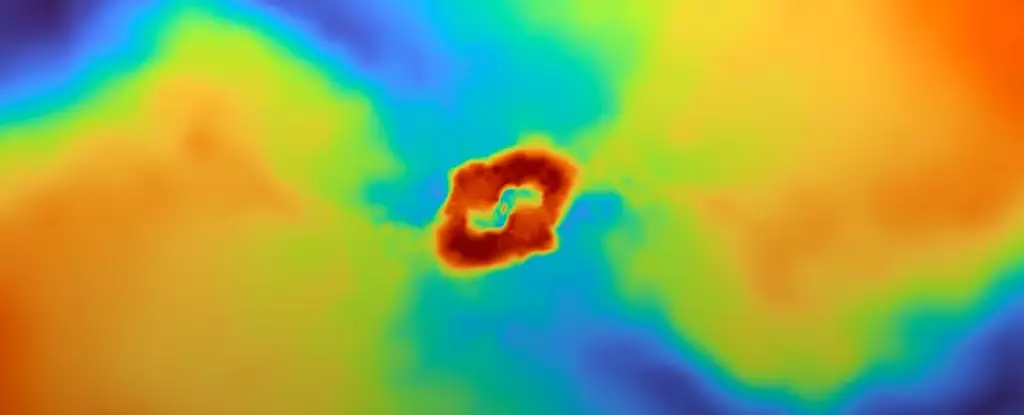In a thrilling turn of events, the aftermath of a colossal collision between two massive planets may have been captured, offering humanity an extraordinary opportunity to witness the birth of an entirely new world. This groundbreaking observation, if confirmed, not only promises to enrich our understanding of planetary formation but also unlocks the mysteries surrounding the intricate processes that orchestrate the emergence of celestial bodies.
The spectacle began in December 2021, when diligent astronomers turned their attention to a seemingly unremarkable star resembling our own sun. To their amazement, they noticed a sudden flickering in its visible light, as it oscillated between moments of nearly vanishing before restoring its previous brightness. This enigmatic star, known as ASASSN-21qj, resides approximately 1,800 light years away from Earth and was initially identified through the ASASN-SN astronomy survey, which detected its gradual dimming.
This dimming phenomenon itself is not uncommon, often attributed to material interrupting the light’s path between the star and Earth. However, it was an extraordinary astute amateur astronomer, Arttu Sainio, who recognized a fascinating connection. Sainio observed that approximately two and a half years before the star’s visible dimming, emissions of infrared light emanating from the same location had increased by around 4%. The emission of infrared light is primarily associated with objects of high temperature, typically reaching a few hundred degrees Celsius.
This revelation raised thought-provoking questions: could these two observations be interrelated, and if so, what extraordinary event could have occurred in the vicinity of ASASSN-21qj to elicit these phenomena?
In a momentous publication in the esteemed scientific journal Nature, researchers proposed a stunning explanation for these captivating observations. They hypothesized that the flickering of ASASSN-21qj and the subsequent infrared brightening could be elucidated by a cataclysmic collision between two colossal planets. Such violent encounters, aptly named giant impacts, are believed to play a pivotal role in the final stages of planet formation, shaping planetary sizes, compositions, and thermal properties. In fact, giant impacts are known to account for the peculiar tilt of Uranus, the unusually dense nature of Mercury, and the origin of Earth’s Moon within our own solar system.
Prior to this groundbreaking discovery, direct evidence of giant impacts occurring within the vast galaxy was meager. However, in order to account for the observations surrounding ASASSN-21qj, the collision between the two immense planets must have released more energy in its initial hours than the star itself emitted. As a result of this colossal impact, the material from both planets would have been intensified, melting, vaporizing, or transforming into a sizzling mass of luminous matter several times larger than the original planets. While the initial flash of light generated by this impact might have been missed by NASA’s WISE space telescope, the residual planetary body formed following the collision will require an extended period of cooling and contraction, conceivably lasting millions of years, before it resembles a recognizable planet.
In its prime, this post-impact body would have emitted light equivalent to several percent of the star’s radiation, accounting for the observed infrared brightening. Additionally, the violent collision would have ejected torrents of debris into various orbits around the star. Some of this debris, subjected to the shock of impact, would have transformed into clouds of minute ice and rock crystals. Over time, segments of this conglomerate cloud interrupted the path between ASASSN-21qj and Earth, causing erratic dimming phenomena by obstructing visible light.
Even with the limited data available thus far, profound insights have emerged from this extraordinary observation. Firstly, to produce the significant amount of energy observed, the post-impact body must have been hundreds of times the size of Earth. Such a colossal body necessitates that the colliding planets themselves were several times more massive than Earth, possibly comparable to the ice giants Uranus and Neptune. Secondly, estimations indicate that the post-impact body maintained a temperature of approximately 700°C. Such a relatively low temperature implies that the colliding planets were not solely comprised of rock and metal but instead contained elements with lower boiling points, such as water. Thus, scientists propose that this collision involves two Neptune-like worlds abundant in ice.
Another intriguing aspect of this discovery lies in the temporal disparity between the emission of infrared light and the observation of debris crossing the star. This discrepancy suggests that the collision likely transpired at a considerable distance from the star, surpassing the Earth’s proximity to the Sun. Such a system, characterized by distant ice giants, bears a closer resemblance to our own solar system than to the densely packed planetary systems commonly observed around other stars.
The excitement surrounding this revelation stems from the tremendous potential to continue observing and monitoring this star system for decades to come, enabling researchers to further test and refine their conclusions. Using advanced telescopes like NASA’s JWST, future observations will allow for the determination of particle sizes and compositions within the debris cloud. Additionally, the chemical properties of the post-impact body’s upper layers and the gradual cooling process of this scorching mass will come under scrutiny. Perhaps, in this awe-inspiring spectacle, new moons will emerge, providing invaluable insights into the mechanisms underlying the formation of planets.
Ultimately, this unprecedented discovery not only captivates the scientific community but also invites us to witness the grandeur and dynamism of our universe as celestial bodies emerge and evolve through colossal collisions. As we expand our understanding of the cosmic ballet that shapes planetary systems, humankind stands poised to unravel the enigmatic origins of the worlds beyond our own.


Leave a Reply